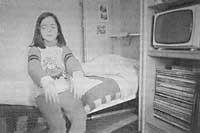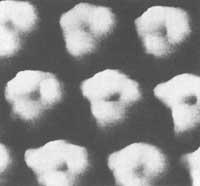Sleepwalkers. At night without realizing
1986/12/01 Agirre, Jabier - Medikua eta OEEko kidea Iturria: Elhuyar aldizkaria
The image of the sonambulo has become common in jokes and comics: a man covered at night, on the roof, surely, who awakens any word or sound, can lose balance and fall. But as with all topics, even though this image is known, it is false: certainty is not so sure, it is not proven that sleepwalkers have their arms extended, simple speech does not wake, etc. What, then, are the manifestations or signs of this fact? What is the real reason for sleepwalking?
Sleepwalking (Latin SOMNUS: Sleep and AMBULARE: ibili), h.d. "sleep" has always been a very curious phenomenon for simple people. Habitual psychiatry has enthusiastically studied the sleepwalking of adults (their appearance in childhood is considered more normal) and has been considered as a neurotic reaction: whoever sleeps leaves the bed and dedicates himself to something that satisfies his desires or calms his tensions (he can start looking for something lost or writing in his day to day).

Of course, sleepwalking will not give us any light. Your family or friends know your rides. Despite what it does, the sonar is not responsible for what was done. Nor will he have that blurred and sketchy memory that we have left after dreaming; his amnesia is total.
Until a few years ago it was thought that the sleepwalker came out of bed while dreaming. At present this hypothesis has been totally discarded thanks to the experiments carried out. Most dreams are known to occur in the superficial phases of sleep, known as REM (Rapid Eye Movement) phases. But in those moments the body is relaxed with everything, and it can hardly be understood that in this situation, when the muscles are slow, the person can get out of bed. On the contrary, it has been proven that the sleepwalker only becomes active when in deep sleep. And in this phase there is no sleep. As one night the person has several phases of deep sleep, a sleepwalker may perform several times their ACTIVITIES before waking up in the morning.
And these activities are not always to go down. In many cases the movement can be much lower: shake in bed, move lips, pull arm sleeve while keeping eyes closed all the time. The sleepwalker is very capable of "working" for more than half an hour. Their eyes may be open or closed: when they are open they have a fixed gaze, but they do not see anything closely.
The sleepwalker moves along his house like a blind man he would never have seen. It's true that you'll ever go to the kitchen, open the fridge and drink milk, but you can do it because you already knew where the fridge was. In an unknown house, this feat would be totally impossible.
Most sleepwalkers move very slowly. Their trajectories are uncoordinated, rhythm change and cordates or shakes are frequent. They evoke the movements of a poorly synchronized robot. With arms hanging on the sides of the body, or with hands doing things, but without touching anything. Family members want to take safety measures to prevent accidents. But be careful! it is useless to place locks on the door; if sleepwalking wants to remove them and the door does, it will go out the window.
As we have seen, the activity of the sonabolas develops in phases of deep sleep. These phases are especially long and persistent in childhood — as we sleep, the growth hormone does its job and the child grows this way — and shorten as the person progresses his age. In older people, above all, complete sleep occurs in a superficial phase or REM and deep sleep disappears almost completely. One of the reasons that almost all sonar are children.
The incidence of sleepwalking, or what is the same, is not very clear. But most specialists claim that one in eight children can be sleepwalking (as we have seen before there are very different levels of sleepwalking). This phenomenon can begin at age eight, repeating itself twice a week. It usually goes away with puberty.
Only a quarantine of adults suffers sleepwalking. And they are almost always found in families with a history or background. This scenario led specialists to think about genetic reasons. But there are other reasons, especially psychic, perhaps the appearance of a repressed sexuality or hidden desires for protection. In adults sleepwalking is accepted as a regression; an unconscious aspiration to become a child again. However, the sonar does not know this inhibition and leaves its unconscious, as other people do when they dream.
All we have seen so far corresponds to HEALTHY sleepwalkers, h.d. apart from this peculiar nocturnal behavior, to people who lead a completely normal life, to those who have full health. There are also pathological ambulisms that appear in people previously affected by neurosis or epilepsy.
Finally we will say that sleepwalking does not necessarily have to appear at night. Recently all the newspapers brought the news of the Swedish soldier who manipulated his rifle while he was sleeping: he shot the rifle and killed his friend. This terrible event occurred at noon: the sleepwalking soldier lay down at ten in the morning after making a night guard. Although the authorities left the boy free from military service, he was tried at the time of the shooting to decide whether he was aware of his actions. The verdict, accompanied by a team of doctors and psychiatrists, was unanimous: "INNOCENT." While he was sleeping, that boy was not at all responsible for his actions.





